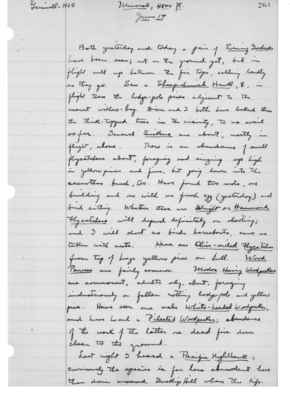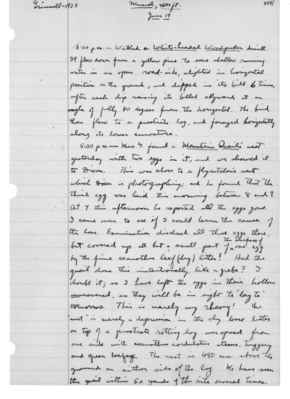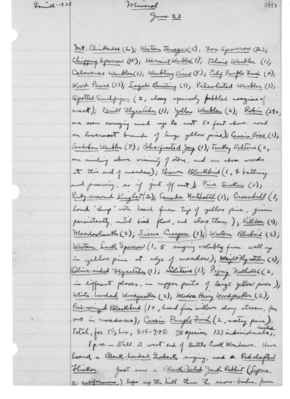Pages That Mention White-headed Woodpecker
1925: Joseph Grinnell's field notes
S2 Page 7
Collector: Grinnell - 1925 Location: Lassen Section (Mineral) Date: June 14, 1925 Page Number: 2463
Both yesterday and today a pair of Evening Grosbeaks have been seen; not on the ground yet, but in flight well up between the fir tops, calling loudly as they go. Saw a Sharp-shinned Hawk, female, in flight thru the lodge-pole pines adjacent to the nearest willow-bog. Dixon and I both have looked thru the thick-topped trees in the vicinity, to no avail so far. Several Siskins are about, mostly in flight, above. There is an abundance of small flycatchers about, foraging and singing up high in yellow pines and firs, but going down into the ceanothus bush, too. Have found two nests, one building and one with one fresh egg (yesterday) and bird sitting. Whether these are Wright or Hammond Flycatchers will depend definitely on shooting; and I will shoot no birds hereabouts, save any (?) taken with nests. Hear one Olive-sided Flycatcher from top of huge yellow pine on hill. Wood Pewees are fairly common. Modoc Hairy Woodpeckers are commonest, adults only, about, foraging industriously on fallen rotting lodge-pole and yellow pine. Have seen one male White-headed Woodpecker, and have heard a Pileated Woodpecker; abundance of the work of the latter on dead firs down clean to the ground. Last night I heard a Pacific Nighthawk; curiously this species is far less abundant here than down around Inskip Hill where the life-
S2 Page 13
Collector: Grinnell - 1925 Location: Lassen Section (Mineral) Date: June 16, 1925 Page Number: 2469
feeding about our campsite. The male has frequently sung from a young fir tip scarcely ten feet directly above the nest, also from the brush all about it, and when hopping on the ground between or thru the bushes. The rim of the nest is 360 mm. above a mat of yellow pine needles; the nest itself is ensconced among the leaning stems of a rather sparse ceanothus integerrimus. It is a large structure, of much coarse pine and other twigs externally, and lined with shredded bark. There are two young, about 3 days old I think, helpless and downy rather than feathery. The old female is very solicitous, coming within 6 feet of us when at the nest; but the male shows little concern, and sings volubly immediately we leave, from within 20 feet of the nest. Mountain Chickadee's nest, with young, in woodpecker hole opening on under side of a leaning stub a foot in diameter and some 15 feet long. Entrance just my height from the ground - 5 ft., 7 in.; diameter of entrance, 44 mm. - so probably was made by a White-headed Woodpecker. Site open, surrounded by dry ceanothus slope; some very small yellow pines nearby, also two yellow pine stumps, sawed off so long ago they are rotting, cleft. The old chickadees come with food freely, altho I am only about 15 feet away under a bush on the dry (?) hill side. Each bird dives directly into the hole, as it arrives,
S2 Page 25
Author: Grinnell-1925 Location: Mineral, 4800 ft. Date: June 19 Page Number: 2480
Later: found the Traill Flycatcher's nest some 7 feet up in a crotch of slender willow stem in the midst of an isolated willow clump in the meadow - just in process of construction. In a tract of old lodge pole pines a little farther along, a crowd of birds was distraught over something, tho I failed to find what the threatening danger was. The crowd included: Juncos, a pair of Robins, a Lincoln Sparrow, a Pigmy Nuthatch (the first I have seen in the Lassen "section"), a Hammond (or Wright) Flycatcher, several Chipping Sparrows, and a pair of Audubon Warblers. Nearby was a (female) White-headed Woodpecker.
As to mammals: winter earthcores of Thomomys monticola occur in places where the ground is well-drained at the sides of meadows but not out in them. The common chipmunk is Eutamias amoenus, about logs overgrown with snowbushes, but they are very quiet now; two visit camp, but so far are shy. A (female) Eutamias senex was trapped in a neighbor's camp yesterday morning at 5 o'clock. Last evening just before sundown, Dixon shot an old male jack-rabbit (Lepus c. californicus) in a tract of sparse snowbush. Mrs. G. has seen another partly grown one in the same vicinity. This must be the extreme easternmost limit of this subspecies in the "section". Also, Mrs. G. and Dixon have both seen individuals of the snow-shoe rabbit (Lepus w. klamathensis).
S2 Page 26
Collector: Grinnell-1925 Location: Mineral, 4800 ft. Date: June 19 Page Number: 2481
3:00 p.m. - Watched a White-headed Woodpecker drink. It flew down from a yellow pine to some shallow running water in an open road-side, alighted in horizontal position on the ground, and dipped it's bill 6 times, after each dip raising its billed skyward at an angle of fully 80 degrees from the horizontal. The bird then flew to a prostrate log, and foraged horizontally along its lower curvature.
5:00 p.m. - Mrs. G found a Mountain Quail's nest yesterday with two eggs in it, and we showed it to Dixon. This was close to a flycatcher's nest which Dixon is photographing; and he found that the third egg was laid this morning between 8 and 9. At 4 this afternoon he reported all the eggs gone. I came over to see if I could learn the cause of the loss. Examination disclosed all three eggs there, but covered up all but a small part of the surface of one egg, by the fine ceanothus leaf (dry) litter! Had the quail done this intentionally, like a grebe? I doubt it; so I have left the eggs in their hollow uncovered, so they will be in sight to "lay to" tomorrow. This is merely my theory! The "nest" is merely a depression in the dry loose litter on top of a prostrate rotting log, overspread from one side with ceanothus cordulatus stems, twiggery and green leafage. The nest is 480 mm. above the ground on either side of the log. We have seen the quail within 50 yards of the site several times.
S2 Page 39
Collector: Grinnell - 1925 Location: Mineral Date: June 23 Page Number: 2493
Mt. Chickadee (2); Western Tanager (5); Fox Sparrow (2); Chipping Sparrow (18); Hermit Warbler (3); Tolmie Warbler (1); Calaveras Warbler (1); Warbling Vireo (8); Calif. Purple Finch (4); Wood Pewee (13); Lazuli Bunting (3) Pileated Warbler (1); Spotted Sandpiper (2, along sparsely pebbled margins of creek); Traill Flycatcher (1); Yellow Warbler (2); Robin (29+, one seen carrying mud up to nest 50 feet above and on lowermost branch of huge yellow pine); Cassin Vireo (1); Audubon Warbler (7); Blue-fronted Jay (1); Turkey Vulture (2, one circling above vicinity of store (?), and one above woods at this end of the meadow) Brewer Blackbird (1, [female symbol] bathing and preening, as if just off nest); Pine Siskin (1); Ruby-crowned Kinglet (2); Canada Nuthatch (1); Crossbill (1, loud "chup" note heard from tips of yellow pine, given persistently, until bird flew, and also then); Killdeer (2); Meadowlark (2); Sierra Creeper (1); Western Bluebird (2); Western Lark Sparrow (1, [male symbol] singing volubly from well up in yellow pine at edge of meadow); Wright Flycatcher (2); Olive-sided Flycatcher (1); Solitaire (1); Pygmy Nuthatch (2, in different places, in upper parts of large yellow pines); White-headed Woodpecker (2); Modoc Hairy Woodpecker (2); Red-winged Blackbird (1+, heard from willows along stream, far out in meadows); Cassin Purple Finch (2, mating pair).
Total, for 1 1/2 hrs., 8:15-9:45: 38 species, 133 individuals.
1 p.m. Still at west end of Battle Creek Meadows. Have heard a Black-headed Grosbeak singing, and a Red-shafted Flicker. Just saw a Black-tailed Jack Rabbit (Lepus c. californicus) lope up the hill thru the snow bushes, from




